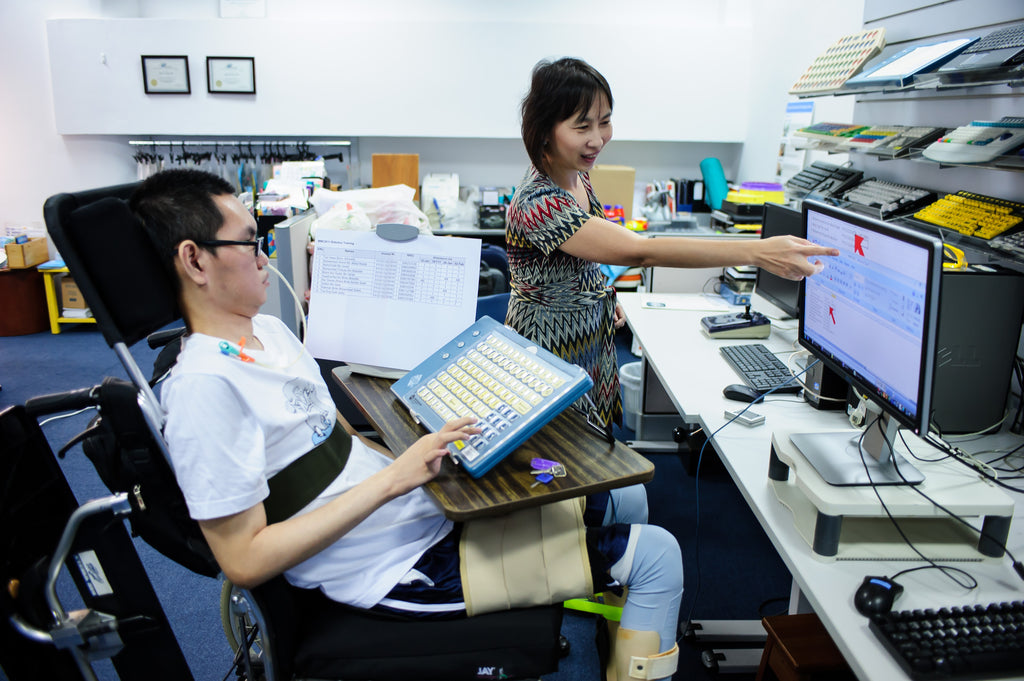With so many on the market, it’s important to look at all the options for braille, text-to-speech or other software and devices to narrow to discover the ones that suit your needs. Assistive technology can come in the form of either low-tech or high-tech devices. For example, a pencil grip is a low-tech assistive technology for individuals with limited hand dexterity and the tecla-e is a high-tech device that allows individuals with limited mobility to access their smart devices, hands-free. No matter the complexity, assistive technologies provide infinite solutions for individuals with vision impairment, hearing impairment, speech or communication impairment, cognitive disability or mobility impairments to increase functional capabilities and perform daily tasks independently.
We know finding the right tool is important and that your search can be overwhelming, so we've outlined four steps you should take before investing in a new assistive technology software or hardware.
Step 1: Use Google or other search engines
The easiest way to do research nowadays is to pick up a computer and do a Google search. You can explore different databases, see what people are talking about on social media and read blogs, reviews, or articles about the latest technologies. Pinterest is one of the most popular social media platforms that individuals use to save thousands of DIY low-tech assistive device ideas as well as high-tech devices available to purchase. You can start by creating an account and pinning all the devices that relate to what you have been searching for, and then narrow down your favourite technologies after reading about each one.
Step 2: Ask for a referral to an Assistive Technology Consultant

Assistive technology specialists can be employed by multiple organizations including resource centres and hospitals. Doctors and professionals including speech therapists, occupational therapists, rehabilitation specialists as well as school educators can have connections with assistive technology consultants in your area and can refer you for an evaluation. Consultants have the most knowledge about assistive technology application and know how to find the ‘best fit’ for different types of users.
Step 3: Go to your local assistive technology resource centre
Resource centres for assistive technologies have become widely used over the years and can be found in major cities all across Canada and throughout the United States, as well as other regions around the world. To find the closest assistive technology resource centre, do an online search or ask a healthcare professional.
What is an assistive technology resource centre?
AT resource centres employ specialists who work with clients of varying abilities to introduce new technologies to users and ensure they are equipped with the knowledge to apply solutions to their everyday lives. Their services are best suited for individuals looking to try specific devices before buying or for individuals who want to have a personalized recommendation of various devices that could fit their needs.
What services do they offer?
Assistive technology resource centres have libraries and databases of all the devices available in their collection; offer consultation and assessment services for new users; allow clients to test equipment, trial new devices and provide in depth instructions, give out loan devices for users to try at home and sell used devices at a lower price. Some centres offer more specific services that could include assisting with job search and training, help students with their educational goals or advocating for inclusive design and accessibility in your area. Visit our website for a map and list of resource centres in North America who loan Tecla devices and other assistive technologies.
Step 4: Ask the right questions
Before investing in the device of your choice, ask yourself several questions about the product including those from the list below from Understood.org.
- Does this tool address you or the individual’s specific needs and challenges?
- Does it utilize strengths?
- Is there a simpler tool that would work as effectively?
- Will it be easy to incorporate into everyday life?
- Is it portable?
- Are you or the individual willing to use it?
- Are you able to use it? (Try a demo if you are unsure.)
- How easy is it to learn to use the tool?
- Will you have support or training in how it works?
- Is the tool compatible with the existing technology you use uses? (e.g. will the software work on your smart devices?)
- If it is for a child, can they use it both at home and at school?
- How reliable is it?
- What technical support is available?
Following these 4 steps will guarantee that the devices you choose will be incorporated into your daily life and enhance your strengths with adapted tasks and hobbies.
Learn more about how tecla-e could be the right assistive device for you or someone you know.



Leave a comment: